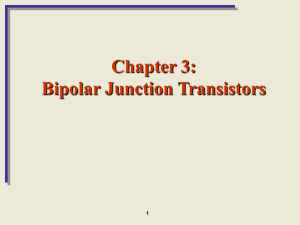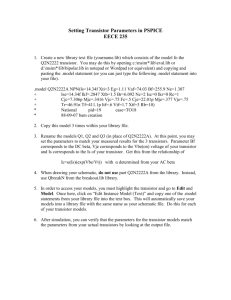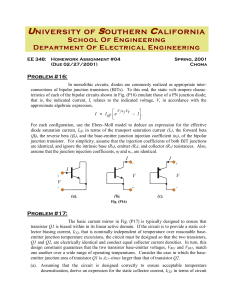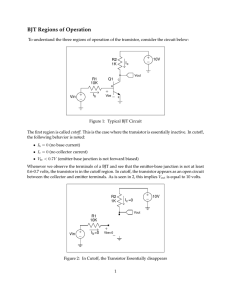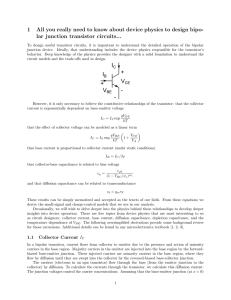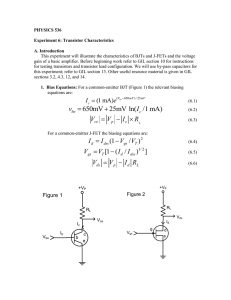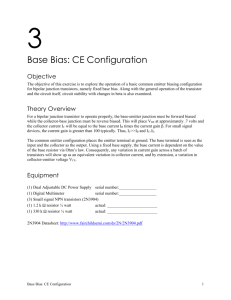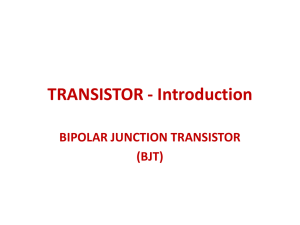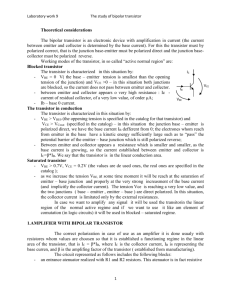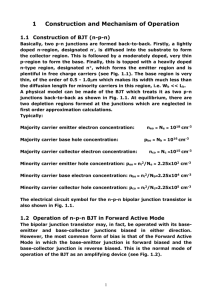3 Transistor Parameters
advertisement
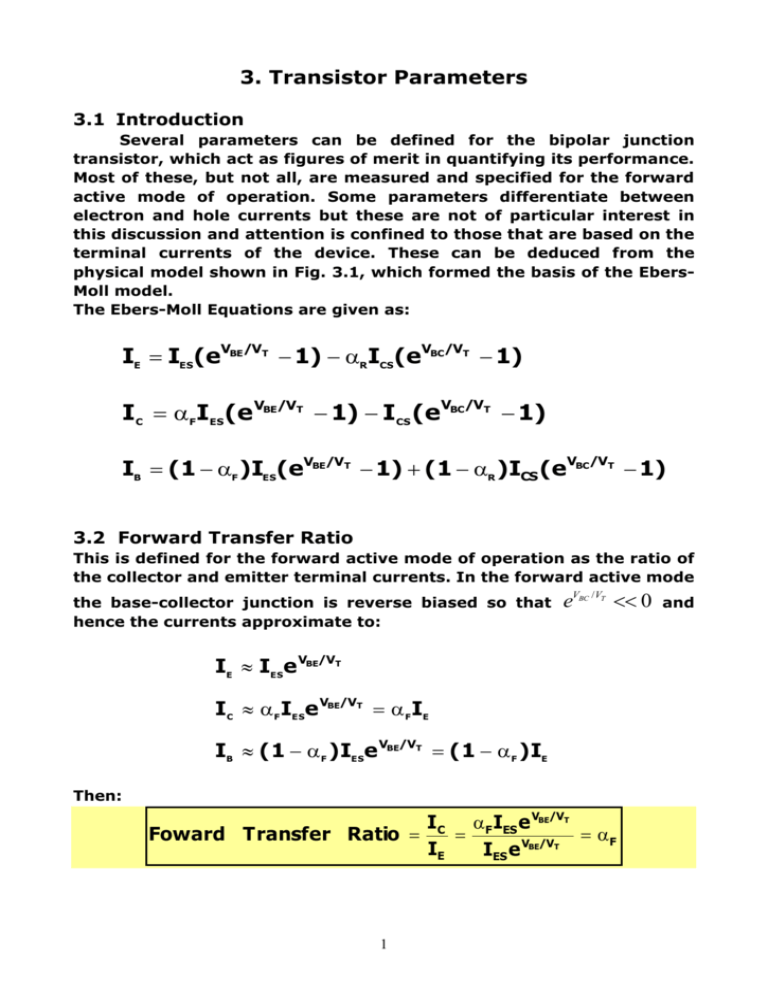
3. Transistor Parameters 3.1 Introduction Several parameters can be defined for the bipolar junction transistor, which act as figures of merit in quantifying its performance. Most of these, but not all, are measured and specified for the forward active mode of operation. Some parameters differentiate between electron and hole currents but these are not of particular interest in this discussion and attention is confined to those that are based on the terminal currents of the device. These can be deduced from the physical model shown in Fig. 3.1, which formed the basis of the EbersMoll model. The Ebers-Moll Equations are given as: IE IES(eVBE/VT 1) RICS(eVBC/VT 1) IC F IES(eVBE/VT 1) ICS (eVBC/VT 1) IB (1 F )IES(eVBE/VT 1) (1 R )ICS (eVBC/VT 1) 3.2 Forward Transfer Ratio This is defined for the forward active mode of operation as the ratio of the collector and emitter terminal currents. In the forward active mode the base-collector junction is reverse biased so that hence the currents approximate to: eV BC / VT 0 IE IESe VBE/VT IC F IESe VBE/VT F IE IB (1 F )IESe VBE/VT (1 F )IE Then: IC FIES e VBE/VT Foward Transfer Ratio F IE IES e VBE/VT 1 and IB (1-αF)IF (1-αR)IR αFIF IF IE B n E p n αRIR C IC IR Fig. 3.1 Model Showing Forward and Reverse Current Components Base Current IF Variation in excess carriers present due to changing base current E Fig. 3.2 C B Minority Carrier Concentration in the Base Region 2 3.3 Forward Current Gain, βF Under steady-state conditions in the forward active mode, the volume of minority charge stored in the base region is constant. The greater part of this is charge in transit to the collector which forms the electronic component of the collector current. A small percentage of the minority charge continually recombines with majority carriers which are replaced with holes supplied by an external base current. Since the base region is very thin and is sandwiched between the two junctions, it is not surprising that the volume of minority charge present in the base exercises a profound influence on the behaviour of the transistor. In fact, the excess minority charge in the base region can be forced to change by modulating the base current with an external signal. The atomic forces operating cause both the recombining charge and the charge in transit to the collector to vary in sympathy. The junction voltages will adjust, in response to the currents flowing, to conform to the exponential laws governing them. However, since the charge in transit to the collector is much greater than the recombination charge, a greater change in absolute charge terms is induced in the collector current than is present in the base current due to the signal. Hence, the transistor is seen to amplify the input signal to the base as shown in Fig. 3.3. small input IC signal RC C amplified output B IB signal developed across a load E Fig. 3.3 The Current Amplifying Property of the Bipolar Transistor 3 This current amplifying property is described by the current gain of the transistor in the forward active mode which is taken simply as the ratio of the collector and base currents. Hence: Foward Current Gain IC FIES eVBE/VT F F IB (1 - F )IES e VBE/VT 1 - F Alternatively: F IC IC IC/IE F IB IE IC 1 IC/IE 1 F Typical values of F range from 40-100 for integrated transistors but can be as high as 300 – 500 for discrete devices. 3.4 Reverse Transfer Ratio and Current Gain, αR, βR The above parameters can also be defined for the reverse active mode when the B-E junction is reverse biased and the B-C junction is forward biased. However, these parameters are not of great interest as the transistor is very inefficient from an amplifying point of view in this mode. Typically αR = 0.1 - 0.5 and βR = 0.1 – 1.0. 3.5 Minority Carrier Lifetime, B This is the average amount of time a minority carrier can survive after being injected into the base region before recombining with a majority carrier. It depends on the physical properties of the device, such as the doping concentration and the dimensions. Typically B = 50 - 100ns. 3.6 Forward Transit Time, F This is the average time it takes a minority carrier injected into the base region to make the transition to the collector region when the transistor is operating in the forward active mode. It can be shown that: 2 Wb2 1W F b b 2Db 2 Lb Typically F = 0.1 – 0.5ns The above parameters will be used in the analysis of static and dynamic performance of the transistor as a circuit switching element. 4

